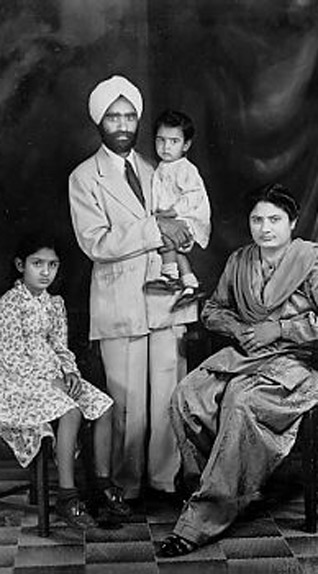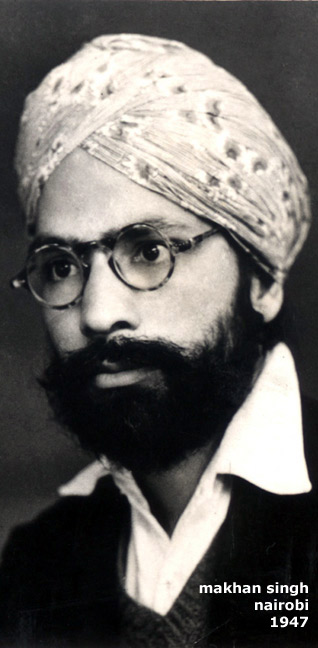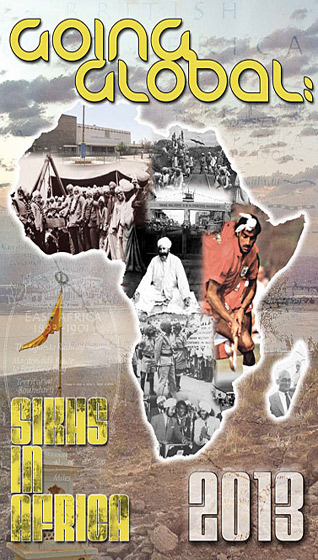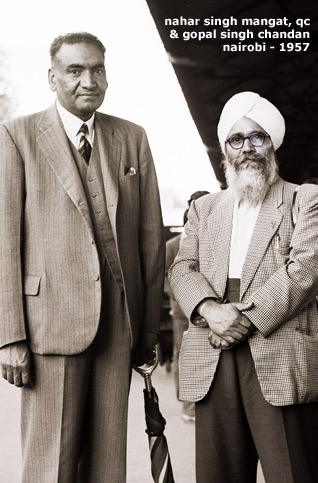
Above: East Africa pioneer Sardar Sampuran Singh Gill, and his family. [Courtesy: Sikhs.org]. Photos below: courtesy, Gopal Singh Chandan, Swaran Singh Nijhar, Amarjit Singh Chandan Collection.



History
Nation Builders:
The Sikhs of Africa
KHUSHWANT SINGH, Chandigarh, Punjab
Recently, someone gifted me with a unique present – a 2013 calendar on the Sikhs of Africa.
Published by Sikhlens, the calendar’s 12 leaves offer an interesting visual and print journey of the Sikhs in Africa, a story that has largely remained untold.
The month of January commemorates the earliest Sikh emigration to East Africa, which approximately began between the years 1895-1902, when they were taken as labourers to lay connections for the Ugandan Railways.
Called the ‘Lunatic Line’, the British had recruited several thousands of Indians -- with many Sikhs serving as managers and foremen -- to lay a 576 kilometre treacherous track from North-west Mombasa which passed through a semi-desert region, to the highlands rising up to 10,000 ft on the equator and down to the bed of the Great Rift Valley, before reaching Victoria.
Flipping the calendar to the next page takes you to February where one gets informed about the Sikhs joining the police. Comprising Askaris or soldiers, the first police force was formed in the late 19th century by the British East-African Company, with men from Punjab being the original recruits. Sikhs from regiments of the Punjab Rifles were sent to protect the railways and the caravan routes.
March draws your attention to the role of the Sikhs in East Africa during World War I. After the declaration of the war in 1914, about 1.5 million troops from India were raised for combat by 1919, out of which Sikhs were a disproportionate majority. The Sikhs were used extensively by the British in their East African campaign against Germany, which started in Tanganyika and spread to surrounding countries.
Once the Sikhs had reached Africa, it was obvious that they would be quickly followed by the establishment of gurdwaras which became centres of learning and culture, in addition to being spiritual centres.
The month of April highlights the advent of these gurdwaras, the first being set up in Nairobi, the foundation of which was laid by one Sardar Kishen Singh in 1909. The second gurdwara to be built was the one in Makindu in 1926, about 100 km from Nairobi on the Nairobi-Mombasa Road.
The fifth month highlights the evolution of the Sikhs in the mainstream, when the British started recruiting and promoting them for higher jobs. As a result, Kapur Singh became the first non-British Inspector of Police in 1895.
The leaf marked June has an interesting anecdote about how the Sikhs got the tag of the KalaSinghas - which they are called until now.
As per the folklore, one Kala Singh who had come from Patiala to Kenya had co-founded a company by the name Munshiram, Kala Singh and Company. In spite of the absence of roads at that time, Kala Singh managed to penetrate the most forbidden areas of the Maasai reserve through sheer determination and courage. And so, Kala Singh came to be known as Kala Singha to all Africans and the name became attached with all turbaned Sikhs.
The next six months of the calendar delve into the role of the Sikhs and their further rise in East Africa in terms of number and confidence. The period marks their ascent as philanthropists, politicians, sportsmen and artists.
The most respected philanthropist mentioned in the calendar is one Baba Puran Singh, also affectionately called ‘Kericho waley babaji’ who immigrated to Kenya in 1916. Story goes that so momentous was his civic contribution that authorities named the Kericho town square after him and called it Sant Puran Singh Square.
Some of the important politicians to emerge in this time span were Makahan Singh, a trade unionist; Nahar Singh Manga, a lawyer and the first Asian to be appointed a Queen’s Council in East Asia; Sir Mota Singh, council member, judge and eventually a knight; and Alderman Mohan Singh, a businessman who became the first non-British deputy mayor of Nairobi.
Sikhs also made their presence felt in the field of sports and are considered the most ‘sports-minded’ people in East Africa to date. Joginder Singh, the first Asian driver to win the Safari Rally thrice, was fondly known as the ‘Flying Sikh’.
Sikh-Africans also excelled in wrestling, volleyball and formed the bulk in hockey contingents in the earlier Olympics – comprising eight in 1956, nine in 1960 and six in 1964. The most outstanding player was Surjeet Singh Deol (senior), who captained Kenya during the 1956 Melbourne Olympics.
The calendar which hangs in my study has been authored by three very passionate Sikhs who were born and raised in East Africa – Jagjit Singh Reyat, whose passion remains photography, was born in Nakru and presently lives is USA; Harjinder Singh Kanwal, a passionate writer who has keen interest in Sikh cultural heritage, was born in Machakos, a small town near Nairobi and presently resides in Coventry; and Pally Singh Dhillon, a computer professional in the US who has written historical fictional books that are set in East Africa. Kijabe: An African Saga was published in 2000.
[Courtesy: Hindustan Times. Edited for sikhchic.com]
March 24, 2013
Conversation about this article
1: Ari Singh (Sofia, Bulgaria), March 24, 2013, 7:20 PM.
I was born in Kenya, so this article is very dear to me. There were also Sikhs who excelled in body-building, judo, karate and Formula Five Racing. And there were many whose physical strength was legendary.
2: Sandeep Singh Brar (Canada), March 24, 2013, 9:07 PM.
Jambo to my fellow Kenyans! Whenever somebody asks what my 'pind' is, I always say, "I'm from Obama's pind". Born in Kisumu, I spent my early years growing up on a sugarcane farm in the Rift Valley. The Kenya of my childhood was a magical place with a strong and vibrant Sikh community. It's such a tragedy how things turned out and so many of us were forced to flee for our personal safety. A paradise lost.
3: Gurinder Singh (Stockton, California, U.S.A.), March 25, 2013, 6:50 AM.
I visited Mombasa, Kenya, for some days in the 1970s. Sikhs were a respected lot in that country and also in Tanzania which was my next stop. They had their own hockey clubs and had sports gymkhanas. In Kenya I was also called Kala Singha. Kala Singh was a merchant who sold his wares in remote ares of Kenya. He also carried life saving drugs, for example, to fight malaria, and distributed them free to the affected folks who had no access to medical facilities. That is why he was so respected. His selfless service gave a good name to all Sikhs there.
4: B.S. (United Kingdom), March 25, 2013, 7:20 AM.
Re Comment #2: "It's such a tragedy how things turned out and so many of us were forced to flee for our personal safety. A paradise lost." You reminisce about the days that your family owned a thousand acres and kept a thousand black servants. You may well call what happened in Kenya a tragedy, but I'm sure most black Africans see it as just and right. As a Sikh, it is my duty to stand with what is just and right.
5: Kanwal Prakash Singh (Indianapolis, Indiana, USA), March 25, 2013, 10:07 AM.
This beautiful calendar is a living testimonials of our cherished heritage, emerging creativity, and a valiant attempt to communicate and share our proud heritage with friends and the family of faiths, cultures and communities. It is not just a wall decoration, it aims to add to our interest in the arts, a powerful universal language of communication; offer us insights and illuminate the Sikh journey, and discover our place and promise among other faiths and cultures, and in nations that we today call home.
6: Sandeep Singh Brar (Canada), March 25, 2013, 5:06 PM.
Re Comment #4: Is it 'just and right' to steal, seize or kill because you are jealous of someone else's success? Sikhs like my Dad and everyone we knew put in back-breaking efforts to build their farms and businesses in the true pioneering spirit. Pioneering Sikh-Kenyans like my grandfather who came to Kenya after the Partition of Punjab to build a better life for his family, started from scratch and succeeded through their hard work and determination in the face of what seemed like insurmountable odds at times. In the process, they built Kenya. It is a tragedy that their hard work and aspirations were destroyed by despotic and corrupt government officials and brutal, murderous criminal gangs that have turned large parts of Africa into a wilderness of lawlessness, violence and corruption.
7: Hardev Singh (Richmond Hill, Ontario, Canada), March 26, 2013, 1:58 AM.
Re Comments 4 & 5: Historical transformations, status quo and social order changes are never smooth. I remember going to a government school, the City Primary School, where the students were streamed up to the 5th year according to the mother tongue. All classmates of mine were Sikh boys. Hindu, Gujarati and Muslim students likewise were streamed in the "Indian" government school. Even the scout troop of mine was language based. My family lived in the Sikh Colony in Nairobi. Later, in 1962, I went to a Catholic school, Opus Dei run Strathmore College which was touted as the first multi-racial educational institution in Kenya. The point I am making is that the Kenyan society was economically and socially stratified. The Africans gained political power but were deprived of economic power. This was in the hands of a small number of about 35,000 whites in the first tier, some 280,000 Asians on the next tier, and the majority Africans with small farms and rural 'dukas' or small shops. Major cities with commercial buildings, main shopping and entertainment centers and better housing and vehicles on the road were mostly Asian. It is the break up of this social and economic order, while right and just, also caused grievance. The means employed were institutionalized and there was plain theft and robbery. My father started work as a teenager for the Railways until his juniors and trainees became his superiors and finally his job was "Africanized". Thankfully he found new pastures in the United Kingdom, like so many others from East Africa.
8: Lakhvir Singh Khalsa (Nairobi, Kenya), March 26, 2013, 4:41 AM.
More history on the Sikhs in Kenya on this link: https://www.facebook.com/feelthekenyaninyou
9: Gurinder Singh (Stockton, California, U.S.A.), March 26, 2013, 10:18 AM.
I had stayed in South Africa for over a year on a company assignment during the apartheid era. I was the only identifiable Sikh there. I did not face any discrimination during my stay. The country was beautiful and well developed ... and enjoyed by a small minority of whites. In comparison, neighboring countries like Zambia and Zimbabwe were performing very poorly due to corruption. I am not a supporter of any race being deprived of its basic rights. But fair administration and corruption-free governments are better for all people than the corrupt ones.
10: Vikrant Singh (Sydney, New South Wales, Australia), March 26, 2013, 11:42 PM.
Thanks for posting that fb link, Lakhvir - I had no idea about the deep roots of Sikhs in East Africa. I spent a couple hours on your site yesterday - just fantastic!
11: Narindar Singh Dhesi (United Kingdom), March 31, 2013, 8:43 AM.
Sardar Harjinder Singh Kanwal has a website on the internet: Sikh Heritage in East Africa. A rich comprehensive Sikh history. In fact my father Waryam Singh 'Khalifa' was a founding member of the gurdwara at Makindu.
12: Amandeep Kaur (Kisumu, Kenya), December 23, 2013, 7:33 AM.
One of the first gurdwaras in Kenya is also in Kisumu. The foundation stone was laid in 1913.
13: Mita (Toronto, Ontario, Canada), September 01, 2014, 8:33 AM.
Indar Singh Hans has included a lot of history of Sikhs in East Africa gathered from his years there in his book ... www.partitionroad.com
14: Harminder Singh (Stratford, Ontario, Canada ), April 14, 2015, 3:20 PM.
I am Nakuru born, old Alidinian from Mombasa, in Canada since 1970. I spent my best childhood and youth years in Kenya and Uganda in various places including Namasagali, Malblamuti, Sagana, Timberoa and Mombasa, in that order, with my loving Station Master father and mother. Africa stays in my bones. I will always cherish those years but now I love my adopted country, Canada, where I raise my two beautiful, loving children, son Robbie and daughter Priya. I am a Canadian citizen and immensely feel proud of it. Love all the dugus from my birth country.
15: Kuldeep Singh Sabharwal (Gravesend, Kent, United Kingdom), October 27, 2015, 1:49 PM.
I came to UK in1965 to my best friend; his name is Paramjeet Singh Manku. We used to go to City Primary School and then DAV School. We still live in Gravesend. I am looking for a dear friend for about almost 50 years, his mane is Charanjeet Singh Lall, he's an architect. We also went to school together. He still lives in Nairobi. If anybody can pass him the message, I would be grateful.
16: Dr Rajiv Shori (Nairobi, Kenya), January 20, 2018, 6:29 PM.
I am a doctor of medicine and a Hindu Punjabi born in Nairobi in 1963. I grew up in Thika in the 1970's and 1980's. I went to the Gurudwara in Thika since 1970 and I am honored to work and live with the Sikhs. After becoming a doctor I worked at Guru Nanak Hospital, Pangani in Nairobi and even today in 2018 I work as a locum doctor in that hospital. I will continue to work and associate with the Sikhs with pleasure anywhere in the world.


